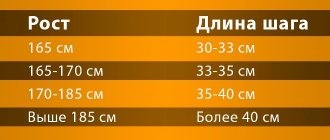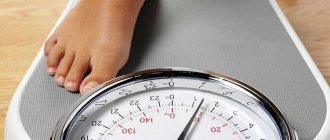Do you know how much walking you need to do per day? The benefits of walking are enormous for everyone, both women and men, everyone knows about this. Getting extra miles every day is very important for your overall health. Scientists have already determined the exact useful number for 24 hours - 10,000 steps. Walking has long been a sport and is divided into types, so you need to have comfortable shoes, a pedometer and a navigator. All that remains is to develop a habit and learn to walk correctly. In this article I will tell you why you should take up daily walking today and not put it off until tomorrow.
It's time to walk
Movement is life. However, in everyday life, not everyone moves every day. You don't have to buy a gym membership right away. A good place to start is walking.
No matter how healthy you are, health must be maintained throughout your life. Lack of movement leads to diseases of the heart, blood vessels, and lungs, as a result of which the period of life is shortened. In addition, lack of physical activity certainly entails weight gain. However, the majority actively refuse, using excuses such as lack of time or lack of motivation.
Physical inactivity negatively affects all organs
But how can we start walking when in the modern world we are always late and dependent on various means of transport - metro, buses, cars, motorcycles. Without which it is impossible to imagine arriving from one point to another. It is known that walking is an accessible, simplest and safest type of physical activity.
There is a trend across Europe of insufficient physical activity. And in the Czech Republic, an observation was carried out from 2008 to 2013, the result showed that the daily number of steps decreased by 850 per day in men and by 1490 in women. It’s worth considering that the time has come to walk more.
Walking is the best cure for illness
Hippocrates also recognized that the benefits of walking for humans are so enormous that they cannot be compared with any medicine. After research, it was found that people had a 31% reduced risk of heart disease and a 32% reduced risk of death.
When you see the result on the scales and notice an improvement in your health, you will also find the answer to the question for yourself - is walking healthy?
In addition, it has been noted that this unpretentious sport prolongs youth. And this is important not only for a woman, but also for a man. In men, muscles work better due to supplying them with oxygen, and the risk of inflammation of the male genital area is reduced.
It is useful to know that every 40-60 minutes of a brisk walk adds as much as 2 hours to our life expectancy. And brisk walks improve brain activity, which means memory, which is very important at any age.
A Brief History of Daily 10,000 Steps
Fortunately for those who are lazy to run, and I am one of those people, there is a way to increase physical activity - walking. A system of 10,000 steps in 24 hours was created, which does not require excessive human effort, and at the same time you can be on the move.
Where did this number come from? Why exactly 10,000 per day is needed?
In fact, this number was chosen completely by accident. In 64 XX century, at the time of the Olympic Games in Tokyo, inventor Yoshiro Hatano created the world's first electronic gadget. The device was called “men-po-kei”, which means “thousand step meter” in Japanese.
Physiologists believe that in Japanese culture 10,000 is an auspicious number, but the creator made it a publicity stunt, and a rather successful one. After the presentation of the device, it took residents of Japan 2 months for the gadget to become the most popular and affordable purchase. Without it, we no longer went out and watched the kilometers traveled with pleasure.
10,000 is a great number
Over the years, the approach to the benefits of daily steps has been scientifically proven through many studies. Let me take a look at how science looks at 10,000 a day these days.
An ancient Chinese proverb says, “If you want to live 100 years, take 100 steps after lunch.” It is known that those who live a long time also walk a lot. Perhaps the secret to longevity depends on walking.
How to force yourself to move every day?
Now that we understand the benefits of walking, it is important to figure out how to force yourself to walk.
- Buy a pedometer. He will constantly push you to take extra steps.
- Set a starting amount per day.
- Add 500 steps.
- Plan some activities during your hike.
- Hang out with others who want to lose weight.
- Use a calorie consumption calculator, which will also become an incentive for brisk walks.
- In heavy rain, you can “do laps” in a large shopping center, because the important thing is to move!
What health benefits do 10,000 steps a day bring?
I'll give you a few examples that should convince you:
Walking is an aerobic type of exercise. Simply put, this is the same activity as running, going to the pool, or going to the gym.
- The body resists stress better, mood improves, and sleep returns to normal.
- Perfectly strengthens muscle tissue, improving and correcting the figure.
- Normalizes the function of the heart and blood vessels.
- The likelihood of many diseases - diabetes, atherosclerosis, osteoporosis - decreases.
- Prevention of diabetes.
- Not a difficult and accessible sport.
- People of almost any age can practice, and there are no contraindications.
- No special skills required.
Let's consider what else is useful for this type of physical activity?
- Good for the respiratory system. Oxygen fills the lungs more intensely, and their activity increases, which is good for health.
- Excellent training for the heart and blood vessels. During walking, the heart works more intensely, the arteries fill with blood, and their tone increases. As a result, the chance of heart failure, heart attack, hypertension and many other pathologies decreases.
- The ability to put your thoughts in order, remove depression, and provide a positive mood.
- Walking helps burn fat and also activates various muscle groups, in particular the abs and legs. And if you need numbers on the amount of fat burned, then you need to take into account the walking speed and weight of the person. Obviously, the higher the speed, the faster the visibility of the effect. In addition, it is directly proportional to weight: the more it is, the more calories disappear. Approximately 200 to 500 calories are lost. For example, fast walking will save you from 450-500 calories, and slow walking up to 250 in one day.
- The outflow of blood in the legs is normalized, which reduces the chance of varicose veins.
- It is especially important for women to take walks, as activity saturates the pelvic organs with blood. This not only prevents female diseases, but also normalizes the functions of the reproductive organs and increases the likelihood of a successful pregnancy.
- Walking is also beneficial for men, as it promotes good blood supply to the genital organs, does not cause congestion, minimizes the risk of developing prostatitis and other pathologies, and sperm is more productive for conception.
- Recommended for people whose work is mental. While walking, the brain has the opportunity to rest and be saturated with oxygen, which leads to better mental activity.
- Walking has a beneficial effect on the functioning of the digestive system, and also helps to avoid problems with constipation.
- Accelerates metabolism, and this guarantees an excellent figure and health.
How steps can cure obesity and normalize sleep
It’s not news that zhor attacks in the evening and it’s very difficult to fight, I know from myself. So I began to practice walking in the evenings from 8 to 10 pm. I can’t give dinner to the enemy yet, but fast walking prevents calories from being stored as fat. Metabolism increases due to movement, and excess from dinner is burned.
There is certainly a connection between excess weight and poor sleep. You won’t sleep soundly with a full stomach and you’ll have nightmares. That is why the number (10 thousand) has been confirmed and is associated with normal sleep and excess weight.
Studies have been conducted based on their conclusions: it is necessary to take from 7 to 10 thousand steps a day, but preferably, of course, 10,000, or even more. In one experiment, literally in 6 months, body weight decreased by an average of 4 kg in 35 overweight people weighing more than one hundred kilograms participating in the study. In the subjects, daily walks of 10,000 steps, in combination with a suitable diet, strengthened the muscles of the legs and buttocks, and decreased waist size.
How to choose the right orthopedic pillow for sleeping - personal experience
Walking and mood
You have certainly noticed when children come from the street, how cheerful and cheerful they are, and why not take a walk with them if it lifts your spirits so much. I know what you are thinking about when reading these lines - the hassle of caring, there is no time. Meanwhile, a 12-week trial was conducted to see how walking affects people's emotional state. And again the results were confirmed in a positive direction. From 10 to 12.5 thousand steps per day reduces anger, anxiety, fatigue, depression, mood and emotions. WOW!
Reduces the risk of cardiovascular diseases
Walking can become an independent cardio workout and make you fully train your cardiovascular system (CVS). In addition, the degree of lowering blood pressure is only slightly inferior to aerobics or fitness.
With age, blood vessels become stiffer. This interferes with the blood vessels' ability to control pressure. Such arteries force the heart to work harder.
And now an experiment lasting four years shows that the more often a person walks, the slower the arteries lose their elasticity, even in the presence of diabetes. Every extra thousand steps per day in diabetics reduces the speed of pulse wave propagation by 0.103 milliseconds.
The speed of propagation of the pulse wave is the degree of indication of vascular stiffness.
And you should not delay walking - left ventricular hypertrophy wears out the heart, and no amount of exercise will return it to its previous state.
Reduces the risk of diabetes
Reducing the load from 10,000 to 1,500 steps in 24 hours leads to a decrease in insulin sensitivity after three days. This means that after just three days of lack of increased physical activity, the prerequisites for the occurrence of type 2 diabetes, high glycation and early aging are formed. Walking normalizes glucose levels in the body and controls the release of insulin.
Glycation - this non-enzymatic glycosylation of proteins is the main mechanism of tissue damage in diabetes mellitus
It is not necessary to follow a regimen - walk 10-12 thousand steps a day all week, 5-6 sessions are quite enough, without risk to health, and then rest for one or two days. Still, it’s worth walking 10,000 steps every day; it has a beneficial effect on health.
Benefits for women during menopause
12,500 steps a day have a positive effect on health during menopause.
Numerous changes occur in the body: decreased metabolism, excess weight gain, depression. Excess weight or obesity is one of the most important problems during postmenopause (51-81 years). Daily walking is an excellent method of counteracting menopause in all its manifestations, including reducing hot flashes.
Experiments show that for women after menopause, 10,000 steps in 24 hours is not enough. Women need to walk at least 12,500. Even for teenage children, the norm is 11,000 for girls and 13,000 for boys.
The benefits of walking for weight loss
Walking to lose weight burns calories, which leads to a decrease in waist, hips, and muscle tone. If you walk daily, the body's systems begin to work more actively, metabolism accelerates, endurance increases, and the heart becomes stronger. Walking perfectly prepares the body for more intense training and disciplines it.
The benefits of walking, according to reviews of those who have lost weight:
- decreased blood sugar;
- stabilization of blood pressure;
- tightening sagging skin, including smoothing cellulite;
- improving the shape of the thighs and calves;
- reducing the risk of cancer;
- strengthening the walls of blood vessels and heart muscle;
- increased body tone;
- relieve stress, improve mood;
- improvement of pulmonary ventilation;
- increase in overall activity.
The emerging trend towards a decrease in human mobility leads to the accumulation of extra pounds. Instead of walking several kilometers, people get into a car and drive the distance while sitting in a chair. To maintain normal body condition and neutralize the negative effects of physical inactivity, you need to walk 5 to 8 km a day, i.e. take at least 6 thousand steps, and ideally all 10 thousand. The more you move daily, the more calories you can burn.
Important! Unlike running, walking does not harm your joints.
Walking or running, which is better?
Of course, both options are good. But not everyone can run.
The benefits and harms of walking:
- Minimum load on joints.
- A natural way to burn extra pounds.
- Beautiful, slender, not over-pumped legs.
- Contraindications: recent leg injuries, ankle sprains. A fast pace is harmful for heart disease.
The benefits and harms of running
- There must be strong ligaments and discs of the spine.
- The muscles of the whole body work better and more actively.
- Increased metabolism - faster weight loss.
- Trains the endurance of the respiratory and cardiac systems.
- It is not recommended to run on hard roads.
- The harm of running for osteoporosis, varicose veins, osteochondrosis, arthritis, arthrosis, scoliosis, spinal hernia, cardiovascular diseases, hypertension.
Even for beginners in running, it is recommended to walk at a brisk pace for two months, gradually making the task more difficult (climbing mountains, overcoming sandy terrain). It turns out that walking is the beginning for all sports - the queen of sports.
How to get rid of ailments
In our cities there are many people who go for walks with sticks. They walk alone or in groups. Everyone is so cheerful and happy with life!
An accessible type of physiotherapy, Nordic walking, is increasingly developing. A light walk with poles can restore the musculoskeletal, cardiovascular and respiratory systems.
Especially useful for older people with sore knees and spine. The main thing is that depression goes away, your mood improves, and your self-esteem goes up!
What type of walking should I choose?
Kinds
Each person chooses his own look.
- Wellness - simple walking. The duration doesn't matter. Up to approximately four kilometers per hour. The pace is governed by a person's purpose.
- Terraincourt - this type involves a deliberately designated route of uneven terrain (mountains, hills). The speed, distance, number of ascents and descents are set in advance.
- Scandinavian - a single exercise with special sticks. When exercising, approximately 90% of the muscles work. Very effective. The duration and pace are different for everyone.
- Sports is an Olympic sport that involves a unique technique of movement over a distance of 6-15 km per hour. The length depends on the age and location of the competition.
You shouldn’t stop at just one pace; it’s interesting to complicate them from simple to complex, thereby training endurance and gaining good health and long life. According to the American Heart Association, an hour of active walking prolongs life by two hours.
Hiking routes
In order not to lose interest, you need to periodically change your directions. Using the map, determine the mileage of new paths and set tasks. My path often lies through the sports ground, where there is an opportunity to do additional exercise - hang on the horizontal bar, do push-ups from a bench, do stretching, etc. And in the summer, I set the task of walking to the river and definitely taking a swim. BLISS!
How many kilometers in 10,000 steps
To make a calculation, it is not necessary to measure steps with a meter; there are formulas.
We will calculate how many kilometers we walk in steps ourselves:
With a height of 160 cm, the length of one step (1.60/4)+0.37=0.77 m 0.77 x 10,000=7700 m
The greater the growth, the more kilometers will be covered. Accordingly, take into account that the speed is not constant, the length of the stride changes, but these are minor things.
HOW MUCH CALORIES ARE BURNED?
When walking, we increase energy expenditure and more calories will be burned. It all depends on the pace of walking.
At a slow pace of 4 km/h, about 200 kcal per hour is spent.
It is necessary to take into account not only the pace, but also the weight.
At an average pace (4 km/h) 3.2 kcal is consumed per 1 kg of weight.
If your weight is 60 kg, then in an hour you will spend 60 kg x 3.2 kcal = 192 kcal
When the pace increases to 5 km/h, the calorie consumption will be 240 kcal (4 kcal per 1 kg of weight)
For comparison, your body will spend only 85 kcal per hour to “sit at rest.”
Table of calorie consumption when walking per 1 kg of weight
4 km/h – 3.2 kcal
6 km/h – 4.5 kcal
8 km/h – 10 kcal
What do you need to walk?
Shoes
Shoes for walking need to be comfortable, practical, ventilated and durable - these are the main factors when choosing them. If you can walk 4 kilometers a day on your own, then you don’t need to work hard, any pair will do, even sneakers, sneakers or something else. However, for long distances it is better to choose comfortable shoes. Do not forget about longitudinal and transverse flat feet, a very common defect, you need orthopedic insoles, purchase them in advance and only try on sneakers with them.
- Running shoes are focused on cushioning the sole to reduce tension in the knee joint. In addition, they are lightweight and ventilated - ideal for the city and city roads.
- Trekking ones are aimed at protecting the ankle, have a uniquely shaped protector, are very durable - designed for forests and mountains. Basketball and futsal - for parquet floors.
- Simple city ones from manufacturers Nike, Reebok, Adidas - ideal for the city, only for short distances.
The main thing when buying shoes for sports walking is to check with the seller for what purpose the product is made.
Cloth
A tracksuit is not as important as sneakers, but still. Choose clothes according to the weather and type of walking. The faster, the lighter the clothes. Therefore, it should be comfortable, well ventilated, and moisture-absorbing.
Do not forget about safety measures: in the dark - a flashlight, reflective tape, an umbrella, even mosquito repellent in the summer will not hurt. I once ran from them. The route was through the forest to the dacha, and there was darkness there... J had to flee.
Pedometer
How many kilometers are there in 10,000 steps? How to count steps and distance covered? Approximately - two steps, a little more than a meter, there is a formula, later we will calculate the exact figure.
But it will be more accurately determined by a special device - a pedometer, smart watch, gadgets. Fortunately, today there is no shortage of these goods. Prices for these products vary, depending on the model and functional characteristics (from 300 to 6000).
The step meter should be a lightweight, multifunctional, compact device. The most profitable option is to order through the online store. Determine for yourself what you need from him:
- Type - electronic, mechanical, combi, 2D, 3D.
- Functions - count steps, heart rate, calories burned.
- Design - on your wrist, in your pocket, on shoes or clothes.
Pedometer on Aliexpress
There is also an alternative way - to install the program on your smartphone. But, the devices have higher accuracy, and they can also determine the pulse. Applications, in turn, free you from financial expenses.
Run in a way that suits you
If you run far fewer kilometers during a workout than you should, then its effectiveness decreases. But there is a principle of specificity that says you become proficient at what you do. For example, if you run slow but long, it means you'll be well prepared for long runs. But you are unlikely to be able to quickly run five kilometers. Long long runs won't help you prepare for shorter but faster ones, but they are great for ultramarathons.
How to walk correctly
There are rules for the technique of movements when walking.
- The body is in an upright position, do not slouch.
- Uphill, lean forward a little.
- Direct your gaze 10–20 steps further.
- Take a step from the hip, pushing off with your fingers, and do not stupidly raise your foot and throw it forward of your body.
- The body weight moves forward with the leg.
- Place the foot on the heel, bending it 450, rolling onto the toe.
- Place your toes straight and not pointing to the sides. Otherwise, the body will sway left and right.
- Don't jump.
By following the walking technique, fatigue will not come soon. A kinesiotherapist teaches how to walk correctly, but there are few of them.
How fast should you walk - 5 heart rate zones
The speed of movement, as well as its distance, is different for everyone. In the case of walking for walks, then it doesn't matter whether it's slow or not. But if the goal is to burn fat and strengthen vital systems, then you should move so that your heart rate reaches the desired pulse zone.
There are only 5 zones and are divided by heart rate (the number of heartbeats) - an indicator of heart function.
| Zones | Load | Heart rate in % | Feeling effect |
| Weak up to 20 minutes or more | 55-65 | Improves health and increases metabolism |
| 2. Fat burning | Average up to 40 minutes or more | 65-75 | Increases overall endurance. Fat burning processes increase.
During metabolism, fats from the depot are burned - body weight decreases. |
| 10 minutes or more | 75-85 | Improves physical fitness and anaerobic power.
More calories are expended due to intense exercise. Energy comes from carbohydrates, fats cannot be burned - there is not enough time. |
| 2-10 minutes, maybe a little more | 85-95 | Anaerobic endurance increases.
Anaerobic metabolism. Fats are not burned, carbohydrates are used for energy. |
| 2 minutes or more | 95-100 | Maximum athletic results are achieved.
The body is at its limit. |
How many calories does 10,000 steps a day burn?
How to calculate fat burning heart rate.
- The maximum heart rate during training is 220 beats per minute, age is subtracted from it.
- Next, keep your heart rate at about 70% of maximum. Suppose if 35 years old, then 220-35=185 is the maximum frequency. Accordingly, 129.5 is 70%.
- Monitor your heart rate 129 plus or minus a few beats - this is the burning heart rate.
For heart disease, heart rate should not exceed 140 beats per minute.
Do not forget that with exercises such as walking, fat begins to disappear only after half an hour of continuous movement. In addition, for faster results, you need to eat right and exercise extra. And without this, the scale arrow will not decrease, but will stand still. In principle, this is also a good result.










